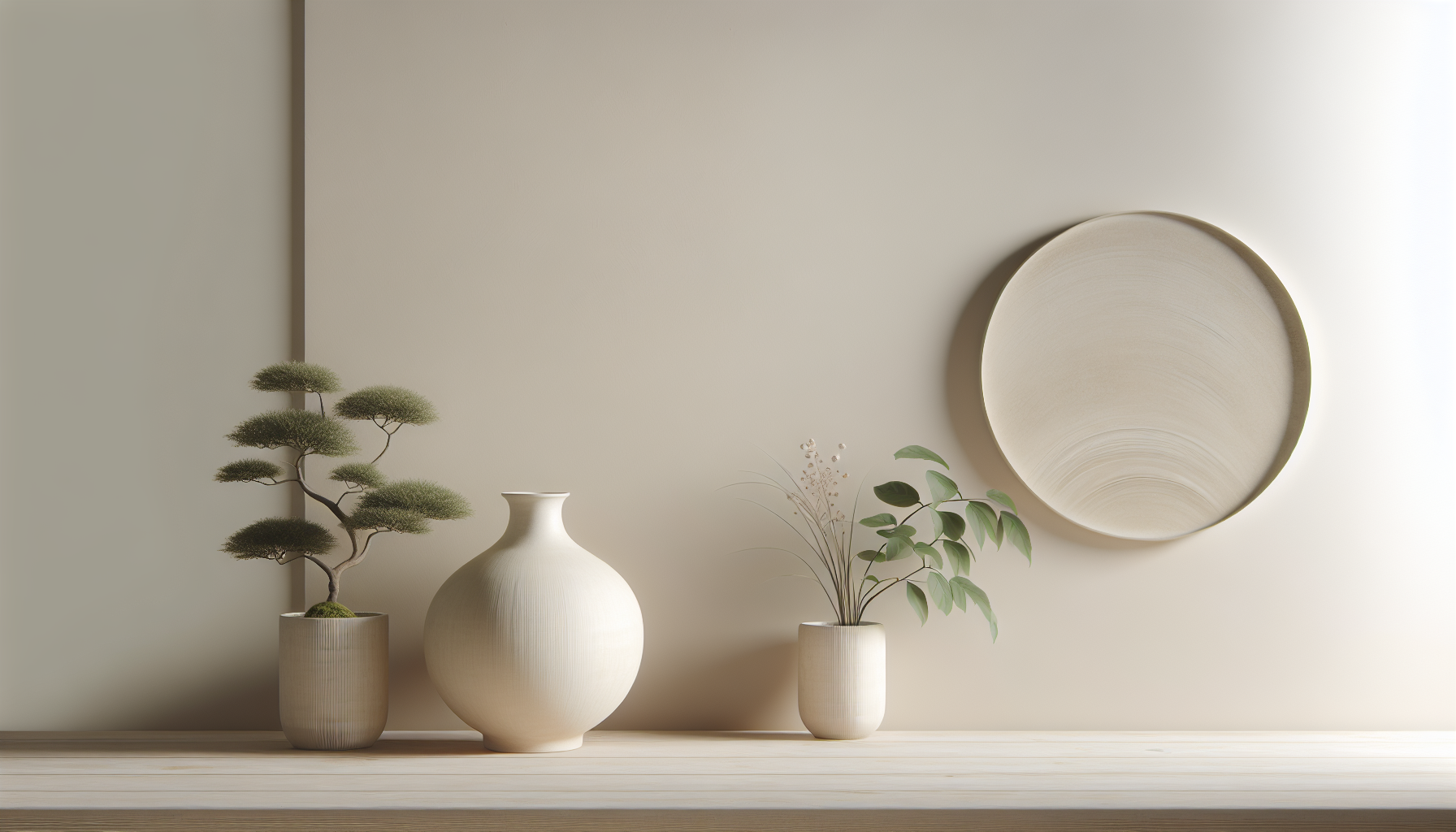What if the right color could completely transform your living space?
In the world of interior design, color can significantly influence the atmosphere and functionality of a room. One color that has captured the essence of harmony and balance in decor is off-white, particularly within the Japandi aesthetic. This design philosophy beautifully blends Japanese minimalism with Scandinavian functionality. Let’s take a closer look at the vital role that off-white plays in Japandi spaces and how it can enhance your home.
Understanding Japandi Design
Japandi design is a fusion of two distinct yet complementary styles: Japanese and Scandinavian. While the Japanese aesthetic emphasizes simplicity, nature, and handcrafted beauty, Scandinavian design focuses on minimalism, practicality, and warmth. The result is a tranquil and functional environment that promotes mindfulness and a connection with nature.
Being aware of the underlying principles of both styles can help you appreciate how color, particularly off-white, fits perfectly into this blend. Off-white serves as a versatile foundation, creating a seamless transition between these two design philosophies.
Key Characteristics of Japandi Spaces
To truly understand why off-white is so important in Japandi design, let’s look at the key characteristics of Japandi spaces.
-
Minimalism
The focus is on simplicity and the removal of clutter. Every item in the room should have a purpose or evoke a sense of joy. -
Natural Materials
Wood, stone, and textiles are used extensively, creating a connection with nature. -
Warmth and Comfort
While it emphasizes minimalism, a Japandi space should still feel warm and inviting. Soft textures and cozy furnishings play an essential role. -
Earthy Color Palettes
Utilizing muted tones inspired by nature is typical. This is where off-white shines as it provides a neutral base that complements various shades. -
Functional Design
Every element in a Japandi space is designed to serve a function, ensuring that beauty doesn’t compromise practicality.
With these characteristics in mind, you can see how off-white not only complements but is fundamental to creating the ideal Japandi environment.
The Color Psychology of Off-White
Off-white is not just a color; it carries significant psychological implications for how you feel in a space. Understanding these can enhance your experience.
Serene and Calming Effects
Off-white evokes feelings of calm and serenity. It can make spaces feel larger and more open, creating a tranquil backdrop for your daily life. This calming effect resonates well with the principles of Japandi design, encouraging mindfulness and relaxation.
Neutral Palette Foundation
As a neutral color, off-white acts as a blank canvas. It allows you to layer in more textured materials and colors without overwhelming the senses. This aspect plays into the Japandi aesthetic beautifully, as combining textures adds depth to the simplicity of the overall design.
Cleaning and Freshness Impression
Off-white often conveys cleanliness and freshness. When you incorporate off-white in your decor, it provides an illusion of tidiness, promoting a fresh and welcoming environment.
Practical Applications of Off-White in Japandi Spaces
Once you understand the significance of off-white in the Japandi aesthetic, you may wonder how to incorporate it into your own space effectively. Here are some practical applications:
Walls and Ceilings
One of the simplest ways to use off-white is by painting your walls and ceilings. This color choice can make rooms feel airy and expansive. It also reflects natural light beautifully, enhancing the warmth of the space.
Choosing the Right Shade of Off-White
Selecting the perfect off-white shade is essential. Here’s a table to assist you in choosing:
| Shade | Characteristics | Best Use |
|---|---|---|
| Ivory | Slightly warm with a hint of yellow | Living rooms, bedrooms |
| Cream | Softer with a rich depth | Cozy spaces, kitchens |
| Snow | Cool undertones that appear crisp | Modern settings, bathrooms |
| Pearl | Subtle with a hint of gray | Elegant spaces, accents |
Once you’ve chosen your shade, consider how it interacts with natural light, as this will affect how the color presents throughout the day.
Furniture Selection
Incorporating off-white furniture can bridge the gap between Japanese and Scandinavian styles.
-
Couches and Chairs: Off-white sofas or accent chairs add a refined touch without overpowering the space. Pair them with darker, earthy tones for contrast.
-
Wooden Furniture: Consider furniture with off-white finishes or upholstery that highlights the wood’s natural grain.
Textiles and Accessories
A key feature of Japandi design is layering textiles. Off-white offers a great base for textiles like throw pillows, blankets, and rugs.
Choosing Textiles
When selecting textiles, consider textures that add warmth, such as:
- Linen: Offers a casual elegance.
- Wool: Ideal for adding coziness to a space.
- Cotton: Great for lighter, breathable layers.
You can strategically place these textiles within your furniture or on walls to introduce comfort and softness while maintaining the overall light and airy feeling of off-white.
Lighting
Lighting can transform how off-white looks in your home. Here are some ideas:
-
Natural Light: Maximize natural light through large windows or mirrors. Off-white walls will reflect this light beautifully.
-
Warm LED Bulbs: Opt for warm lighting fixtures to give your off-white decor a soft glow, enhancing warmth without overpowering it.
Off-White in Japandi Kitchens
The kitchen is often considered the heart of the home, and off-white can elevate this space entirely.
Cabinetry
Off-white cabinets can create a clean and sophisticated look. Pair with darker wood or metal accents for a striking balance that adheres to Japandi design principles.
Countertops
Selecting off-white stone or quartz countertops adds elegance. They are less prone to showing stains compared to darker colors while retaining a timeless appeal.
Backsplashes
Using off-white tiles for your backsplash can tie in beautifully with your overall kitchen aesthetic. Combine these with wooden shelves or accessories to maintain harmony with the Japandi theme.
The Role of Off-White in Japandi Living Rooms
In the living room, off-white can create a calm center for family and guests to gather.
Combining with Natural Elements
Integrate off-white with wooden furniture, plants, and natural materials. This blend emphasizes the organic feel characteristic of Japandi design.
| Element | How to Incorporate |
|---|---|
| Plants | Use off-white pots to blend in with foliage |
| Wooden Accents | Pair with dark wood to create a contrast |
| Artwork | Choose off-white frames to complement artwork |
Choosing off-white for accents like throw pillows can also prevent busy patterns while maintaining softness.
Balance with Accessories
Use various textures and off-white shades to layer your decor. This adds depth without overwhelming the minimalist feel of a Japandi space.
Off-White in Japandi Bedrooms
Creating a serene bedroom environment is essential for restful sleep. Off-white plays a critical role here.
Bedding and Linens
Consider using off-white sheets, comforters, and pillowcases to create a cohesive palette. Layer these textiles with earthy tones or charcoal grays for contrast.
Furniture Choices
Off-white dressers or nightstands can contribute to the calming atmosphere, particularly when complemented with natural wood finishes or accents.
Wall Art
Select off-white frames for your artwork, keeping the vibe serene while ensuring that the focus remains on the pieces you love. Incorporate elements of nature which resonate with the Japandi ethos.
Balancing Off-White with Accent Colors
It’s essential to know that while off-white creates tranquility, it also benefits from strategic accent colors that embody the Japandi spirit.
Earthy Tones
Incorporate deep greens, soft browns, and muted rusts to add life while maintaining the calming essence of off-white. Earthy tones remind you of natural landscapes, adhering to the core principles of both Japanese and Scandinavian design.
Dark Hues
A touch of dark blue or gray can create depth when partnered with off-white, achieving a sophisticated contrast that still feels inviting. Use these hues in large furniture or accessories for a balanced look.
Pops of Color
If you enjoy a more vibrant aesthetic, don’t shy away from adding bold accessories. However, ensure they are used sparingly to maintain harmony within the overall Japandi design.
| Accent Color | Recommended Uses |
|---|---|
| Green | Plants, vases, or artwork |
| Brown | Wooden accents, textiles |
| Navy Blue | Cushions, rugs, or smaller furniture pieces |
Maintenance of Off-White Surfaces
One significant aspect of working with off-white is the maintenance of its aesthetic appeal. Here’s a quick guide:
Cleaning Tips
-
Regular Dusting: Off-white surfaces can show dust and dirt more readily, so be proactive with regular cleaning.
-
Use Non-Abrasive Cleaners: Ensure that you choose suitable, non-abrasive cleaning agents to maintain the finish on your furniture and walls.
Addressing Stains
-
Spot Clean: Address spills immediately with a gentle cleaning solution.
-
Avoid Harsh Chemicals: Over time, these can alter the color or finish of off-white materials.
Bringing It All Together
Implementing off-white in your Japandi space isn’t just about choosing a color; it’s about creating a feeling of balance, simplicity, and joy. From walls to textiles to furniture, off-white serves as a versatile foundation that unites various elements.
Creating Your Personal Zen
As you work on incorporating off-white into your Japandi design, remember to stay true to your vision. Your home reflects your personality and lifestyle; an off-white palette’s calming essence will only enhance that.
Conclusion
The role of off-white in Japandi spaces is multi-faceted. It’s a color that breathes life into your interiors, enhances functionality, and brings forth tranquility. By thoughtfully selecting shades, materials, and complementary colors, you can create a harmonious environment that aligns beautifully with the principles of Japandi design.
So, are you ready to elevate your space with off-white? The journey towards a balanced, serene home starts now!

